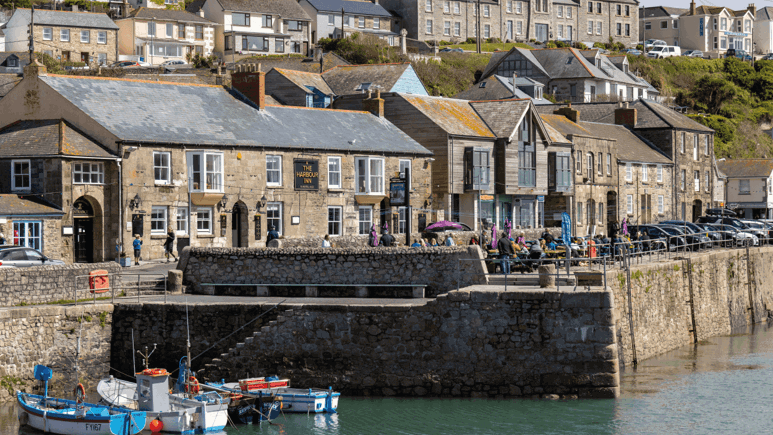Harbour Inn: Our latest renovation project in Porthleven
W e’re excited to announce the Harbour Inn’s exciting renovation project, and while we’ll be closing our doors for a brief period over the winter months, we can’t wait to welcome you back.

Both our restaurant and rooms will receive a full transformation over the next three months, just in time for spring and the famous Porthleven Food Festival.
Before the project is fully underway, we’re having a quick catch-up with Paul, our archivist, and Caroline, our interior designer, to find out a little more about the pub and what we can expect.
Caroline:
What is the inspiration behind the development of the Harbour Inn?
The Harbour is a fantastic pub with a great team, set in a gorgeous location. With a bundle of tradition and history tied up in it that we felt it important to honour, our focus is on creating a warm, inviting, and exciting space for people to spend quality time in. In refurbishing the rooms too, we’re hoping to create the perfect place to get some much-needed R&R, away from the hustle and bustle of everyday life.
What can guests expect to find upon reopening?
A more cohesive and inviting space, with plenty of cosy nooks to sit and while away the hours. We’re ensuring the pub has better flow, connecting the trading areas and, in both the trading area and bedrooms, we’re focusing on rich colours and textures to bring the spaces to life while reflecting and respecting the building’s history.
What development at the Harbour Inn are you most excited about?
I’m looking forward to seeing all the materials and finishes come together, bringing the history and character of the building back to life. Reflecting and enhancing the history of the pub is so important, and we’re focusing on natural materials to ensure the integrity of the building is maintained.
What impact will this have on the pub and the Porthleven community?
Pubs have always been about the community and are a space for everyone to enjoy – I think it’s as simple as creating a great space for the community that reflects how both Porthleven has changed and people use of the pub, as well as ensuring longevity for the site. We’re not trying to reinvent the wheel, but instead focus on creating inviting spaces that work all year round.
How long will the development take and what is the process?
We’re aiming to have both the trading areas and the rooms completed by the spring. We have to be mindful of the fact the buildings hold a lot of history, so a sensitive approach is required to ensure we are doing the right thing for the building, and also for the customers. Throughout the project, we’re checking in to make sure we maintain the integrity we first set out with.
Paul:
When was the Harbour Inn built and who by?
Architecturally, the building looks to be late 18th to early 19th century in date. It also has a 19th century extension. It’s likely that the building was built as a private hotel, possibly by William Edgcombe Cudlip who appears as the earliest owner of the premises. William Cudlip’s son, Pender (1835–1911), became a noted Anglican clergyman, theologian and writer. By 1870 the hotel was owned by the Porthleven Dock Company. When built, the hotel was half the size of what it is now, only the south section was known as the Commercial Hotel, the northern section was a dockside building. In 1838, the Rowe family were proprietors; the Thomas, Carah and Holloway families were tenants into the 20th century. In 1927, it was leased by the dockyard to Ellis Brewery; Edward Dunstan was the tenant. Ellis Brewery was merged into the St Austell Brewery business in 1934, however, a 25 lease was not taken up by St Austell until 1937. Its name was changed in 1946 to the Harbour Hotel.
How long has St Austell managed the property?
It was owned by the Porthleven Dock Company until 1978, although has been leased by the brewery from 1937. The hotel was restored to private ownership until 1985 when it was then purchased by St Austell Brewery.
Can you tell us a bit more about Porthleven's history as a fishing port?
Porthleven, as a harbour, developed significantly during the early part of the 19th century when William Cookworthy shipped his locally quarried China Clay to his Plymouth-based porcelain factory; granite was another popular export. The census returns also show that fishing and boat building were local occupations. Yet, its usefulness as a port was limited due to its vulnerability to the strong prevailing Atlantic winds and rough seas. Its steady rise in population during the 19th century (220 in 1811 grew to 1,259 in 1879) saw new buildings being established to serve the community, the most notable being the church (1842), lifeboat station (1863), coastguard station (1866), chapel (1883), and the Bickford-Smith Institute (1884, built on the site of an inn called the Fisherman’s Arms). The institute, with its dominant 21m-high clock tower, housed a reading room, a committee room, a curator's living room and two bedrooms. The port was taken over in the 1850s by Harvey & Co, a Hayle-based firm, and they made major alterations to the harbour (much to the annoyance of the local fishing fleets) including building the massive sea walls we see today. By 1913, the harbour was busy receiving coal steamers and vessels carrying cement, bricks, and timber.